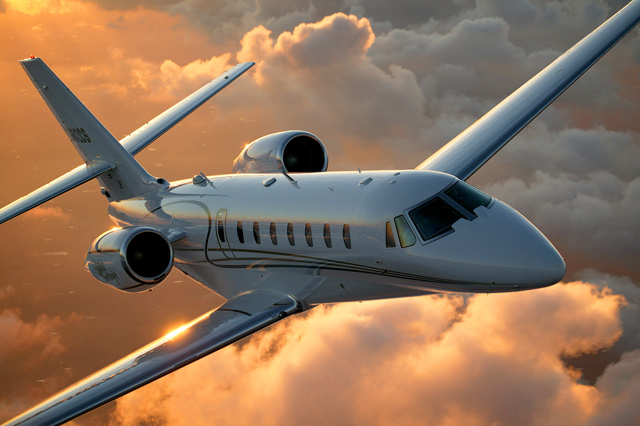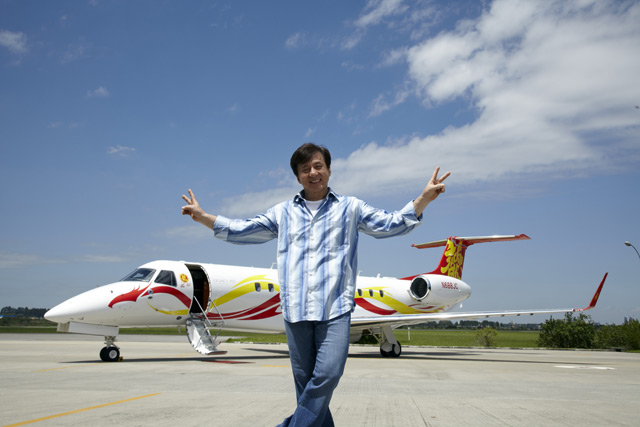Jackie Chan is many things - movie icon, kung-fu exponent and philanthropist. In 2012, Chan also became the face of business aviation in China after becoming Brazilian airframer Embraer's brand ambassador.
His brand new Legacy 650, emblazoned with a vibrant red and yellow paint scheme with Chan's first name and a dragon on its tail, was on static display at an air show in Shanghai in March.
 |
|---|
| Cessna A Cessna/AVIC joint venture will manufacture the Citation Sovereign |
Embraer is seeking to make further inroads into China. The 650's list price for 2012 is $29.5 million, but Chan is believed to have received a substantial discount. That pays for itself if it helps Embraer increase its footprint in what is fast becoming one of the most important business aviation markets in the world.
"To have the first Embraer Legacy 650 in China go to Jackie Chan illustrates how the cutting-edge technology, comfort and productivity of this aircraft allow operators in China to travel throughout the world with more efficiency and ease," said Ernest Edwards, president of Embraer Executive Jets, at the delivery ceremony.
Bombardier, Embraer's Canadian rival, says in its latest forecast that the number of business jets in China could increase to 2,470 in 2030 from just 150 at the end of 2011. This makes it the third largest region in the world for deliveries in those 20 years.
"Demand for business jets should increase as barriers come down," adds Bombardier. "We expect that the cultural acceptance of business aviation, the rapid growth of high-net-worth individuals, the plans for new airports, and the recent improvements to flight planning regulation and airspace liberalisation will allow business aviation to blossom in China over the next 20 years."
SHANGHAI SHOWCASE
If the Asian Business Aviation Conference and Exhibition (ABACE) at Shanghai in March was any gauge, that is already happening. Organised by the US-based National Business Aviation Association (NBAA) and Asian Business Aviation Association (AsBAA), the event had 27 aircraft on static display at the Shanghai Hawker Pacific Business Aviation Service Centre and 156 exhibitors in a 4,000m² (43,000 ft²) hangar.
Many were Chinese and Hong Kong-based firms that offer business aircraft management, charter and brokerage services. Senior officials from the Civil Aviation Administration of China (CAAC), the Shanghai airport authority and other representatives from regulators in other countries also attended the event.
"The support ABACE received from these important officials demonstrates their understanding of the value business aviation can provide to China and the broader Asian region," says Ed Bolen, president and chief executive of the NBAA. "Nearly one-quarter of those exhibitors were companies based in Asia. These companies understand that ABACE is a very effective venue for reaching their target market and gaining visibility in the industry."
Some from the business aviation community in other parts of Asia were a little unhappy that the annual show will continue to be held in Shanghai until 2016. The move, however, clearly reflects the importance of China to many of those present.
China itself wants a share of that pie. At ABACE, state-owned airframer Aviation Industry Corporation of China (AVIC) and Cessna agreed to set up a joint venture to manufacture the Citation Sovereign in China by end-2013 and the Citation Latitude around 2014 after it obtains certification. Once the production of those mid-sized aircraft begins, the joint venture will develop and manufacture a large aircraft.
Cessna says that the agreement gives it "the opportunity to be a part of China's dynamic growth in aviation from the ground floor". For the Chinese, however, the deal is part of a national programme to tap on Western technology, if necessary, to produce virtually every class of aircraft from large passenger airliners to two-seaters in-country.
"We can't only allow Western companies to sell aircraft in China. We want this business too. AVIC has the mandate to manufacture several types of business jets and establish our presence, just like what China has done in the motorcar business," says Wang Yawei, president of AVIC's business aviation division, AVIC Aviation Techniques.
"The rapid development of China's economy has resulted in a boom in business aviation here, and we want to be competitive in the global market too."
Until that happens, Western manufacturers will continue to grow. After two years of negotiations with the Chinese government, Embraer finally reached an agreement to convert its old ERJ145 line in Harbin into a Legacy 650 production facility. This meets a requirement for large-cabin aircraft, the most popular in China.
Even maintenance, repair and overhaul firm Lufthansa Technik could establish a completions centre in Asia, with Walter Heerdt, its senior vice-president for marketing and sales, saying: "Sooner or later we have to come here or we will not get the best share of this market."
Bombardier and Gulfstream may not manufacture business jets in China, but they are boosting their sales and after-sales support teams in an effort to market their aircraft aggressively to an increasingly savvy customer base.
They are helped by Chinese financial institutions, which are finally getting behind the business jet market. China's ICBC Financial Leasing has signed a deal to take up to 10 Legacy 650s, while Minsheng Financial has deals for various models including the Gulfstream G550 and G450, Bombardier Global 6000, Hawker 900 and 4000, and the Dassault Falcon 7X.
Almost all of these aircraft are destined for the domestic market, in which the operating environment is rapidly improving for business jets. Michael Han, Bombardier's regional vice-president for business aircraft sales in China, says this is because "business aviation is now perceived as an essential business tool".
He adds: "Despite the fact that business aviation's growth in China is somewhat recent in comparison with other regions, our customer base in the country is very knowledgeable of the different business jet products available and the benefits of owning a private jet."
That is why NetJets, the world's largest fractional ownership and charter firm, has taken its first steps into China via a joint venture with a consortium of investors. Zhuhai-based NetJets China will provide business aircraft charter and management services to its existing customers and customers in the greater China region.
 |
|---|
| Embraer Brand ambassador Chan poses in front of his Embraer Legacy 650 and its custom paint scheme |
"Our aim is to introduce NetJets' brand of unmatched standards for managing private aircraft and provide aircraft owners in China with the ultimate in safety, security and reliability." says NetJets chairman Jordan Hansell.
NetJets China vice-chairman Eric Wong adds: "We are witnessing demand from both domestic and established customers in the US and Europe."
Jason Liao, who used to sell Bombardier and Hawker Pacific jets in China before starting his own consultancy for business jet buyers, adds that manufacturers and sales teams must not treat the country like a monolithic block.
"China is a big country with diversified requirements. China consists of many different markets just like western Europe. While one solution works in one region, it may not work in another region. We need to offer a tailored solution," he adds. "The current business aircraft are designed to meet the requirements of Western people. That will have to change."
This also comes as the operating environment and infrastructure improves. More airports are being built, for example, even though China still has only 100 of them compared with around 5,300 that cater to business jets in the USA. In the financial capital of Shanghai, business jets can now also use the city's Hongqiao airport, although - in a typically Chinese quirk - they are not allowed to depart eastwards.
EASING RESTRICTIONS
While the military eased its tight grip on the country's airspace a little bit in recent years, business jets are often not able to fly at their optimal altitude, which is typically higher than that for airlines. Foreign-registered aircraft also attract higher landing fees, government fees, navigation fees and other ground handling costs, although landing permits are now easier and faster to come by.
There are now a handful of Chinese fixed base operators, although they are not allowed to sell fuel to subsidise their operations as that is controlled by the government. Service levels are still inconsistent.
There is a looming pilot shortage, especially since airline pilots in China are often tied to expensive and long-term contracts. That is a challenge as foreign pilots are not permitted to fly to remote or sensitive airports. It also takes longer and is more expensive to train Chinese pilots because of the curbs on low-altitude flying, although more flight schools are coming up.
Chris Buchholz, chief executive of charter and management firm Hongkong Jet, says that opening low-altitude airspace for training, opening high altitude air space for private jets, reducing restrictions to create a level playing field for foreign aircraft and allowing FBOs to make a profit on fuel sales would help in the industry's development.
Source: Flight International
















